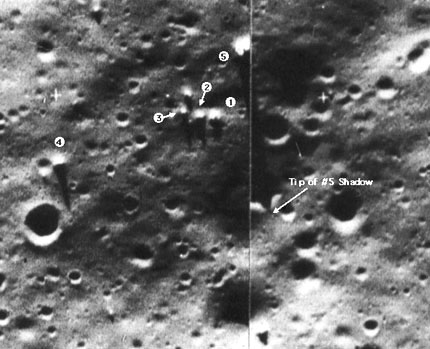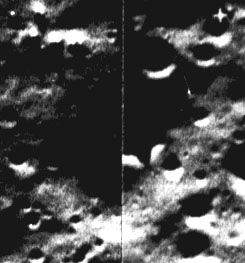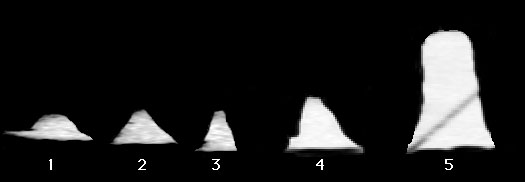The Blair Cuspids: A Mystery Revisited
Lan Fleming
LanFleming@aol.com
To view the images and text below in their
intended postions, please increase the width of your browser window to
the maximum extent possible.
In 1966, NASA released a photograph taken by Lunar Orbiter 2 of a region
on the western edge of the Sea of Tranquility that showed several objects
casting unusually long shadows. A few scientists at the time speculated
that the shadows were too elongated to be cast by common lunar boulders
or ridges. Among them was William Blair, reportedly of the Boeing Institute
of of Biotechnology. Blair noted that the objects casting these shadows
appeared to be arranged in a subtly regular fashion that, together with
the seemingly anomalous height of the objects, suggested an artificial
origin. These objects came to be known as the Blair Cuspids. While there
is some evidence that NASA was at first interested in the unorthodox possibilities
raised by Mr. Blair and others, an official explanation was quickly settled
upon that attributed the elongated shadows to a very low sun angle. A brief
account of the discovery of the Blair Cuspids and how they came to be dismissed
as the product of "uncritical" thinking is
here.
.
When the photograph was released, the NASA public affairs office identified
it according to a numbering system that has since become obsolete, so there
was no way authenticate the image or to access the photographic support
data listing the sun angle at the time and place of the photograph. This
information on the illumination geometry is of critical importance in evaluating
the validity of the official explanation of why the shadows were so long.
Thanks to the efforts of Fran Ridge of the Lunascan Project, Mike
Lomax, and the espcially to the kind assistance of the National Space Science
Data Center (NSSDC), the correct frame number, LO2-61H3, was located a
few months ago. Knowing the frame number, we were able to acquire copies
of the 8X10 inch black and white negatives directly from NSSDC. Figure
1 below shows the small section of Frame LO2-61H3 containing the Cuspids
and their shadows. The numbers in the photograph reference five of the
objects that will be discussed in more detail here.
 Figure
1. The Blair Cuspids and the Rectangular Trench. This JPEG shows a
section of LO2-61H3 with each pixel 2/3 the size of the smallest resolvable
feature at a 3:1 contrast ratio. A larger GIF version (345K) with each
pixel 1/2 times the smallest resolvable feature can
be downloaded by clicking here
Figure
1. The Blair Cuspids and the Rectangular Trench. This JPEG shows a
section of LO2-61H3 with each pixel 2/3 the size of the smallest resolvable
feature at a 3:1 contrast ratio. A larger GIF version (345K) with each
pixel 1/2 times the smallest resolvable feature can
be downloaded by clicking here
The quality of the negatives is greatly superior to the old washed-out
photographs that have appeared in a few books in decades past.
With the correct frame number, we were also able to quickly reference
the photographic support data in the Lunar Orbiter 2 catalog to find the
angle of sun light illuminating the objects in the photograh. The catalog
data showed that the sun was in the East at an angle of 79.1 degrees from
the lunar vertical, or 10.9 degrees above the lunar horizon. While this
sun angle is in fact low, it is by no means low enough to support the claim
that the shadows were cast by common boulders. From the support data, it
was also determined that this region is located at lunar coordinates 15.5
degrees East, 5.1 degrees North. In close proximity to the main group of
"Cuspids," is an unusually regular rectangular depression. The shadow of
Cuspid #5, the longest by far of the Cuspid shadows, falls across this
trench and ends almost at the southern edge of the partially-shadowed interior.
 Figure
2. The Trench. The contrast has been increased by 40% in this image,
making the darker region of the trench nearly black to reveal the unusual
rectangular shape of this depression. The corner of the trench at the one-o'clock
position is an almost unnaturally well-defined right-angle. When an unusual
feature such as this trench is found in close proximity to other unusual
features of an entirely different kind, such as the "Cuspids", it is reasonable
to suppose that the possibility for an artificial origin of all the features
is substantially increased. This is so because a common geological explanation
is made more difficult and an appeal to improbable coincidence becomes
more necessary to support a natural origin for the disparate features.
Figure
2. The Trench. The contrast has been increased by 40% in this image,
making the darker region of the trench nearly black to reveal the unusual
rectangular shape of this depression. The corner of the trench at the one-o'clock
position is an almost unnaturally well-defined right-angle. When an unusual
feature such as this trench is found in close proximity to other unusual
features of an entirely different kind, such as the "Cuspids", it is reasonable
to suppose that the possibility for an artificial origin of all the features
is substantially increased. This is so because a common geological explanation
is made more difficult and an appeal to improbable coincidence becomes
more necessary to support a natural origin for the disparate features.
But how different are these Cuspids from garden-variety moon rocks?
What should be a reasonable - albeit tentative and approximate - reconstruction
of the Cuspids' appearance as viewed in profile is shown in Figure 3 below.

Figure 3. Strange Shapes In Profile. These profile
images are really negative images of the shadows of the 5 objects indicated
by the numbers in Figure
1. The background has been blacked out by hand to emphasize the
overall shape of each object.
In Figure 3, the shadows have been compressed in the direction of their
length according to the simple trigonometric relationship between an object's
height, H, the length of its shadow, Ls,
and the tangent of the sun's elevation angle, A, above the surface on which
the shadow falls. This relationship is:
H = Ls tan(A)
Because the first four cuspids appear to be situated on a fairly horizontal
surface, the value of angle A was taken from the NASA support data to be
the sun's elevation above the horizontal, 10.9 degrees and the images of
the shadows were compressed by the value of that angle's tangent, 0.193.
A greater compression, corresponding to a sun angle of 8 degrees (tan(8)
= 0.14) was used for the profile of Cuspid 5 because its shadow falls over
the surface of the rectangular "trench", which is sloping downward away
from the sun, thus effectively decreasing the sun's elevation above the
surface.
The
problem of the uncertainty of sun angles and the rationale for the ones
selected for these profile images is discussed at length here.
The detailed contours of the objects are lost in these profiles due to
the irregularities of the lunar surface and due to the blurring caused
by the image compression algorithm. However, the general shapes of all
the objects except the first can still be clearly be seen to differ radically
from the shapes of common lunar boulders and ridges. The profiles suggest
that Cuspids 2 through 5 have heights greater than their widths, which
would be a very unstable placement for a randomly placed boulder and even
more unusual for a cluster of them. The hills and ridges of Luna tend to
be very low and rounded. The great lunar mountain Pico Mons in Mare Imbrium,
for example, has a height only 16% of its width. Cuspids 2 though 4 are
conical or pyramidal, while Cuspid 5 (still the tallest even with a lower
sun angle assumed) appears to be a cylinder. Based on the assumption that
the sun's elevation is 8 degrees above the slope on which Cuspid 5's shadow
is being cast, the object itself would have a height of approximately 15
meters or 50 feet. Because of its large size, Cuspid 5 and its shadow may
present a possible solution to the problem of sun angles and surface slopes,
which is discussed
here.
Cuspids Page
2
Cuspids Pge
3
Back to VGL Home Page
 Figure
1. The Blair Cuspids and the Rectangular Trench. This JPEG shows a
section of LO2-61H3 with each pixel 2/3 the size of the smallest resolvable
feature at a 3:1 contrast ratio. A larger GIF version (345K) with each
pixel 1/2 times the smallest resolvable feature can
be downloaded by clicking here
Figure
1. The Blair Cuspids and the Rectangular Trench. This JPEG shows a
section of LO2-61H3 with each pixel 2/3 the size of the smallest resolvable
feature at a 3:1 contrast ratio. A larger GIF version (345K) with each
pixel 1/2 times the smallest resolvable feature can
be downloaded by clicking here
 Figure
2. The Trench. The contrast has been increased by 40% in this image,
making the darker region of the trench nearly black to reveal the unusual
rectangular shape of this depression. The corner of the trench at the one-o'clock
position is an almost unnaturally well-defined right-angle. When an unusual
feature such as this trench is found in close proximity to other unusual
features of an entirely different kind, such as the "Cuspids", it is reasonable
to suppose that the possibility for an artificial origin of all the features
is substantially increased. This is so because a common geological explanation
is made more difficult and an appeal to improbable coincidence becomes
more necessary to support a natural origin for the disparate features.
Figure
2. The Trench. The contrast has been increased by 40% in this image,
making the darker region of the trench nearly black to reveal the unusual
rectangular shape of this depression. The corner of the trench at the one-o'clock
position is an almost unnaturally well-defined right-angle. When an unusual
feature such as this trench is found in close proximity to other unusual
features of an entirely different kind, such as the "Cuspids", it is reasonable
to suppose that the possibility for an artificial origin of all the features
is substantially increased. This is so because a common geological explanation
is made more difficult and an appeal to improbable coincidence becomes
more necessary to support a natural origin for the disparate features.
